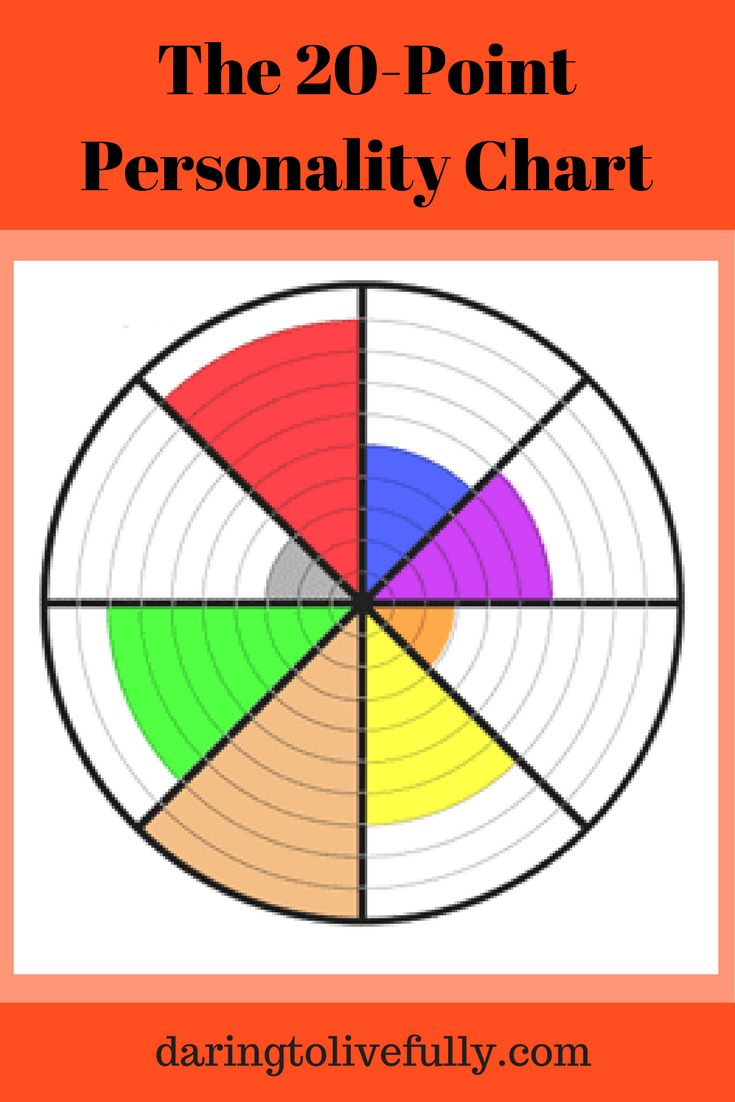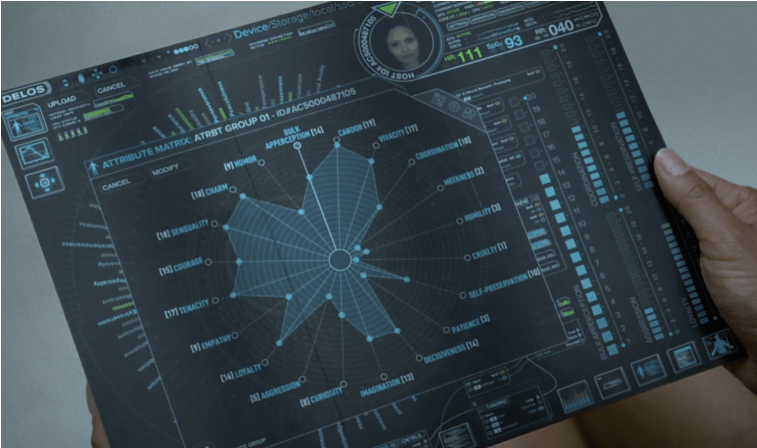
A personality chart can help you become the person you want to be.
A few days ago I discovered a TV show called Westworld. Westworld is a theme park populated by incredibly life-like androids—called “hosts” –who play the typical characters that existed in the American Wild West:
- Cowboys;
- Ranchers;
- Saloon keepers;
- Bandits;
- Lawmen;
- Prostitutes; and so on.
Humans visit this world in order to live out their cowboy fantasies (with the androids catering to their every whim).
 Gradually, the androids become more and more self-aware. Maeve Millay, a brothel madam, is one of the first hosts to realize the true nature of her reality: she’s an android who’s being controlled by humans and being used for their entertainment. In Episode 5 of the first season, Maeve surprises one of the technicians—Felix– by “waking up” while he’s repairing her after her latest “death”. In the next episode, Felix explains to Mauve how the hosts are created, codified, and maintained.
Gradually, the androids become more and more self-aware. Maeve Millay, a brothel madam, is one of the first hosts to realize the true nature of her reality: she’s an android who’s being controlled by humans and being used for their entertainment. In Episode 5 of the first season, Maeve surprises one of the technicians—Felix– by “waking up” while he’s repairing her after her latest “death”. In the next episode, Felix explains to Mauve how the hosts are created, codified, and maintained.
He also explains to her how they’re given personalities to match the character that they’ll be playing in the theme park. Maeve is shown a chart with 20 different personality traits on it, with a rating from 0 to 20 for each one.
Here are the 20 personality traits on the chart:
- Bulk Apperception
- Candor
- Vivacity
- Coordination
- Meekness
- Humility
- Cruelty
- Self-Preservation
- Patience
- Decisiveness
- Imagination
- Curiosity
- Aggression
- Loyalty
- Empathy
- Tenacity
- Courage
- Sensuality
- Charm
- Humor
Here’s what Maeve’s personality chart looks like:

And here’s Felix’s explanation of the chart:
“It’s your personality on a 20-point scale. Like, ‘coordination’: if you’ve got a 5 that means you’re clumsy as hell. But if you got a 15 that means you’re an athlete.”
Maeve is unhappy with the rating she’s been given on some of the traits on her personality chart, and she asks that they be changed. That is, she asks for, and receives, a personality upgrade.
I was thinking about this idea of a personality chart, and how it could be applied to self-improvement (because that’s what happens when you’re a self-improvement blogger). It occurred to me that a personality chart could be a great personal development tool.
Below you’ll discover how to create your own personality chart, and how to use it to become the person you want to be—that is, to give yourself a personality upgrade.
How Is Personality Determined?
If the hosts’ personalities on Westworld are determined by their programmers, what is a human being’s personality dependent on? An individual’s personality depends on their brain structure; patterns of thoughts, feelings, and behaviors; and their levels of different hormones and neurotransmitters. These are influenced by four factors:
- Heredity;
- Physical environment;
- Culture; and
- Particular experiences.
That is, an individual’s personality is based on their genes interacting with their environment.
Can A Person Change Their Personality?
If the programmers on Westworld want to change a host’s personality, all they have to do is change the rating for the personality trait that they want to modify. So, for example, if one of the hosts isn’t interacting well with the visitors to the theme park, the programmers can choose to give that host more charm, humor, or sensuality.
But can a person change his/her personality? I would say “yes” from personal experience. In addition, there are scientific studies that back me up.
A study published in the Journal of Personality and Social Psychology found that when study participants changed their daily behavior to match the personality changes that they wanted to make, they were able to make significant personality changes over the course of the 16-week study.
In another study–from the University of Manchester and the London School of Economics–the lead researcher, Chris Boyce, had the following to say:
“We found that our personalities can and do change over time — something that was considered improbable until now — and that these personality changes are strongly related to changes in our wellbeing. Our research suggests that focusing on who we are and how we relate to the world around us has the potential to unlock vast improvements in our wellbeing.”
How to Create Your Personality Chart
Creating a personality chart is a three-step process. The three steps are explained below.
Step One. Determine the Personality Traits to Measure.
The first step in creating your personality chart is to determine the personality traits that you’re going to measure. I suggest that you measure the following 20 personality traits:
- Charisma – the ability to attract, charm, and influence those around you.
- Perseverance—the ability to keep going despite setbacks and obstacles.
- Confidence – belief in your ability to deal effectively with the world.
- Compassion – sympathy for the suffering of others (or yourself) and wanting to alleviate that suffering.
- Courage – acting despite fear.
- Humor – the ability to be amused, and be amusing to others.
- Agreeableness – being kind, approachable, and easy to get along with.
- Resilience – the ability to bounce back from adversity.
- Extraversion – being high energy and sociable.
- Aggression – being forceful and assertive.
- Decisiveness – the ability to make decisions quickly and effectively.
- Integrity – being honest and having strong moral principles.
- Self-Discipline – the ability to stay focused and do what needs to be done.
- Patience – the ability to tolerate delay, difficulty, or annoyance.
- Curiosity – having a strong desire to learn new things and being open to new experiences.
- Ambition – having a strong desire to achieve.
- Optimism – having the disposition to look at the more favorable side of events, and having the expectation that things will work out well.
- Leadership – the ability to inspire, motivate, and lead other people.
- Conscientiousness – being responsible, having high impulse control, and being dependable.
- Neuroticism – being emotionally unstable and anxious, and having a tendency to overreact.
Step Two. Rate Yourself on Each Personality Trait.
The second step is to rate yourself on each personality trait on a scale from 1 to 20. There are three different approaches you can use for this.
- Rate yourself subjectively. Just ask yourself: “How would I rate myself on each of these personality traits?”
- Ask someone you know well to rate you. You can also ask several people for their input and write down the average rating that you receive from them for each of the personality traits.
- Find a test you can use to rate yourself on each of the 20 character traits. For example, here’s a test for rating how confident you are.
Step Three. Create Your Chart.
The third step is to create your chart. Do the following:
- Draw a circle and divide it into 20 segments.
- Label each segment so that each one represents one of the 20 personality traits you’re measuring.
- Then, label each spoke of the wheel from 1 to 20, where 1 is closest to the center of the circle, and 20 is the outer edge of the circle.
- For each personality trait, place an “x” on your score or rating for that trait. Lastly, connect all your marks.
And, there you have it: you’ve created a personality chart.
How to Change Your Personality
Once you’ve created your personality chart you can analize it and determine what changes you would like to make. As an illustration, you may decide that you need to be more resilient and courageous, and that you need to be less aggressive.
Then, create your game plan. For example, as I explain in my post on 19 Ways to Be More Conscientious, if you want to be more conscientious you should take action such as the following:
- Specify a day, time, and place each month for paying bills.
- Create a budget and start monitoring your spending.
- Clean up after yourself.
- Start planning your day the evening before.
- Every Sunday plan your weekly menus, go grocery shopping, and do some prep work so that you can cook and eat healthy meals all week.
- Don’t take on more commitments than you can handle.
- Finish what you start.
I’ve also written about concrete steps you can take to be more resilient, more charismatic (and interesting), and more optimistic. For the other character traits, conduct your own online research, find a good book on Amazon, or find a self-development course that will help you to craft a game plan on how to proceed.
Three months after you’ve started taking action to modify your personality traits, create another personality chart. How have things changed? Has your score improved for the personality traits you want to change? If not, take corrective action. If so, keep going until you’ve gotten the results that you’re after.
Conclusion
I consider myself to be a great example of someone who has changed their personality through conscious effort. I’m much more outgoing, resilient, perseverant, positive, and confident than I used to be.
In addition, I’m currently working on being more patient and conscientious. Live your best life by creating a personality chart and using it as a self-improvement tool.
And, in case you’re wondering whether you should start watching “Westworld”, I highly recommend it (I usually don’t like sci-fi shows, but this one is terrific). Here’s a trailer:





Related Posts:
- 17 Ways to Be Kind to Yourself
- How to Fall In Love With Yourself
- How to Manage Worry – 8 Healthy Ways to Deal With Worry
- 8 Ways to Stop Taking Things Personally
Did you enjoy this article? Subscribe to “Daring to Live Fully” by clicking here and get free updates.




 Marelisa Fabrega is a lawyer and entrepreneur. She holds a Bachelor of Science in Business Administration from Georgetown University in Washington, D.C., as well as a Juris Doctor from the Georgetown University Law Center. You can learn more about her
Marelisa Fabrega is a lawyer and entrepreneur. She holds a Bachelor of Science in Business Administration from Georgetown University in Washington, D.C., as well as a Juris Doctor from the Georgetown University Law Center. You can learn more about her 





